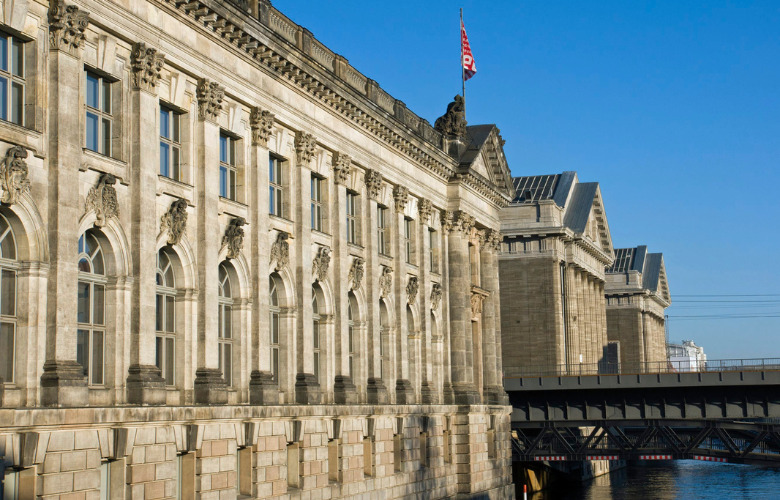
The Pergamon Museum is one of the most visited and possibly most controversial museums in Germany. It is located on Berlin’s Museum Island and houses original, reconstructed monumental buildings such as the Pergamon Altar, the Market Gate of Miletus, the Babylonian Ishtar Gate, and many other priceless historic artifacts. As you can imagine, over the years many questions have been asked as to why these artifacts are in a museum in Germany.
The Pergamon Museum was designed by famous German architect Alfred Messel.
Its construction was overseen by Ludwig Hoffmann and lasted twenty years, from 1910 to 1930.
A smaller building initially stood on the same site for just a few years before being torn down. It housed the important excavation finds unearthed by the Berlin museums, such as the frieze panels from the Pergamon Altar, reclaimed from the earth in digs that lasted from 1878 to 1886.
Inadequate foundations, however, soon resulted in the building becoming structurally unstable and it had to be demolished.
The new, larger Pergamon Museum was built as an enormous three-wing complex. It now houses three of the “Staatliche Museen zu Berlin’s” (state-owned museums of Berlin’s) collections: the Antiques Collection, Near-Eastern Museum, and the Museum Islamic Art.
The impressive reconstructions of massive archaeological structures – the Pergamon Altar, the Market Gate of Miletus, the Ishtar Gate and Processional Way from Babylon, and the Mshatta Facade – have made the Pergamon Museum famous throughout the world.
With the result that it is the most visited museum at the Staatliche Museen and in Germany as a whole.
I went to the Pergamon Museum for the first time on a school trip when I was 18. This was 33 years ago, and even back then you could not visit Berlin without having been at least once in this incredible museum.
Flying to Berlin with my classmates was my first flight ever. So, I was already going way beyond what I had ever seen or experienced before. Then, I saw the Museum Island, which is magnificent.
Due to the pricelessness of the collection and the aim to give everyone the best possible, quiet reflection time inside its enormous, beautiful halls, the Pergamon Museum always only allowed (and still only allows) a limited number of people inside the museum at all times.
Thus, we waited in line for almost two hours. Which back then, for us teenagers, seemed like forever. Yet we forgot our annoyance the instance we walked into the museum.
I was speechless at the time. It was as if a portal into another world had opened. We had time-travelled and switched geographical locations all in one swoop.
I don’t think I closed my mouth once in the couple hours I spent inside the Pergamon Museum. It hung open in expression of what must have been the best kind of shock I had ever experienced.
Especially the Ishtar Gate fascinated me to no end. It had once stood in Babylon and was the eighth gate to the inner city. The gate was constructed in 575 BC by order of King Nebuchadnezzar, and was done in glazed blue brick, showing rows of dragons.
The Ishtar Gate was considered one of the Seven Wonders of the World.
Believe it or not, standing before it, you could feel its powerful presence to the core of your being. The original, glazed bricks were a strong, dark blue.
My thoughts propelled me back to ancient Babylon and I wished I could have seen the structure in its entirety. The blue walls around me whispered of the souls and history of Babylonian grandness. And I listened in awe.
I was spellbound and simply stood before these blue walls for a very long time. Absorbing the impact the artifact had on its modern-day surroundings. Time-travelling.
Apart from the Ishtar Gate, the other artifacts were amazing, too.
The Pergamon Altar was built during the early 2nd century BC on one of the terraces of the acropolis in Pergamon city.
Standing in front of the altar it felt as if an entire Greek temple had been brought into the museum. How was that even possible? To have a building within a building? My 18-year-old brain was struggling to grasp it all.
The sheer size of everything was mind-blowing (a word I usually detest but which fits this experience precisely).
Since 1999, the Pergamon Museum has been named a UNESCO World Heritage Site. And, believe me, you should not miss it when you come to Berlin.
As wonderful as it is to be able to travel to another time and space simply by stepping through a doorway in Berlin, however, the immense cultural and historical treasures of the Pergamon Museum have always raised questions of true ownership.
The Pergamon Altar and the Market Gate of Miletus were both transported from Turkey, for example. And since the museum’s opening in 1930, there has been controversy over the legitimacy of the acquisition of the collection. Many have suggested that the collection be returned to Turkey.
According to an article in Daily Sabah from 2020, Turkey and Germany have, over the years, set up a cultural committee to discuss the return of the artifacts. But the committee’s meetings thus far failed to yield results for Turkey.
Germany, for its part, claims the artifacts in the Pergamon Museum were acquired by legal means. But the Turkish government’s calls to produce the documents to prove the legality of the artifacts’ acquisition have gone unanswered to this day.
Official Website Pergamon Museum
Article on Daily Sabah “Germany resists calls for return of artifacts smuggled from Turkey decades ago”
The Pergamon Museum on Wikipedia
When Sailors Were Stagehands – Debunking a Bit of Rigging History
The 5 Oldest Amphitheaters in the World


Liam Klenk was born in Central Europe and has since lived on four continents. Liam has always been engaged in creative pursuits, ranging from photography and graphic design, to writing short stories and poetry, to working in theatre and shows. In 2016, Liam published his first book and memoir, 'Paralian'.
Read Full Profile© 2021 TheatreArtLife. All rights reserved.

Thank you so much for reading, but you have now reached your free article limit for this month.
Our contributors are currently writing more articles for you to enjoy.
To keep reading, all you have to do is become a subscriber and then you can read unlimited articles anytime.
Your investment will help us continue to ignite connections across the globe in live entertainment and build this community for industry professionals.